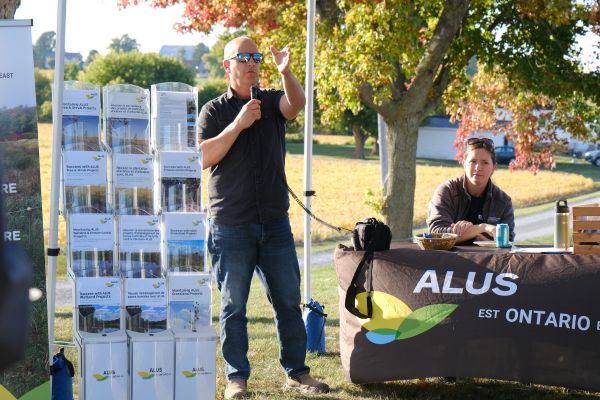Ross Grant, along with his father and brother, own a dairy and cash crop operation on the northern edge of Cornwall, Ontario. During the last decade, Grant has planted an impressive number of trees on his land, both to create sustainable lumber harvesting opportunities for the future, and to provide wildlife habitat on his lands.
“We’re currently at over 31,000 trees planted through the Raisin Region Conservation Authority,” says Grant. “And I’m not done yet!”
Grant’s first project with the Raisin Region Conservation Authority (RRCA) was in 2015, when he planted 7,250 native and naturalized trees in a fallow field where soil conditions were less than ideal for conventional crops. With the advice of the RRCA, Grant chose conifers and hardwoods for this initial planting: white pine, white spruce, white cedar, Norway spruce, red maple, and white oak. Planted as seedlings ranging in height from 20 to 60 centimetres, some of the trees are now over 6 metres high.
“Sometimes I feel like those last ten years just flew by. I’m really glad I took the time to get those trees planted,” he says. “It’s true when they say the best time to plant a tree is 25 years ago, but that the second-best time is right now.”
Grant added another 11,480 trees the following year, this time adding tamarack to the mix. Known for being the only conifer that loses its needles in the fall, tamarack is a go-to option for planting on land that can be too wet for crops or other tree species.
“Tamaracks have relatively shallow roots, so they really do well in areas with lots of available moisture,” says Grant.
Some of Grant’s fields are crossed by the south branch of the Raisin River. In an effort to protect his banks against erosion, and to create a habitat corridor for wildlife, he planted over 2,500 trees in the riparian areas between his fields and the river. This natural buffer also helps prevent nutrient runoff from entering the watercourse.
With the help of the RRCA, Grant is now gearing up to plant a 1-kilometre-long riparian buffer further downstream on the Raisin River.
“As a farmer, I’ve always felt there doesn’t have to be a conflict between running your business well and taking care of the environment, especially when there are programs that can help you,” he says. “I just like doing my part.”
The RRCA provides a variety of forestry services for projects of all sizes – including full-service planting on projects of 500 trees or more – to enhance forest cover in the region, mitigate flooding and erosion, and generally enhance the health and function of local watersheds.
RRCA’s full-service program offers significant cost savings through partnerships with Forests Canada, ALUS Ontario East, and other partners. Services include site planning and preparation, seedling purchase and planting, and follow-up assessments. For smaller projects, the RRCA offers an over-the-counter tree program within its jurisdiction.
Select stewardship projects at the Grants’ farm were undertaken in part with the financial support of the Government of Canada through the Canada Water Agency. This project has received funding support from the Government of Ontario. Such support does not indicate endorsement by the Government of Ontario of the contents of this material. Additional funding was provided through ALUS Ontario East. Views expressed here are those of the RRCA.

 Ross Grant (left) talks about his tree planting projects during a stewardship tour at his farm in Cornwall.
Ross Grant (left) talks about his tree planting projects during a stewardship tour at his farm in Cornwall..jpg) RRCA staff planting trees by the banks of the Raisin River on the Grants’ farm.
RRCA staff planting trees by the banks of the Raisin River on the Grants’ farm..jpg) This white spruce seedling is one of many trees that will help stabilize the riverbanks at the Grants’ farm.
This white spruce seedling is one of many trees that will help stabilize the riverbanks at the Grants’ farm.